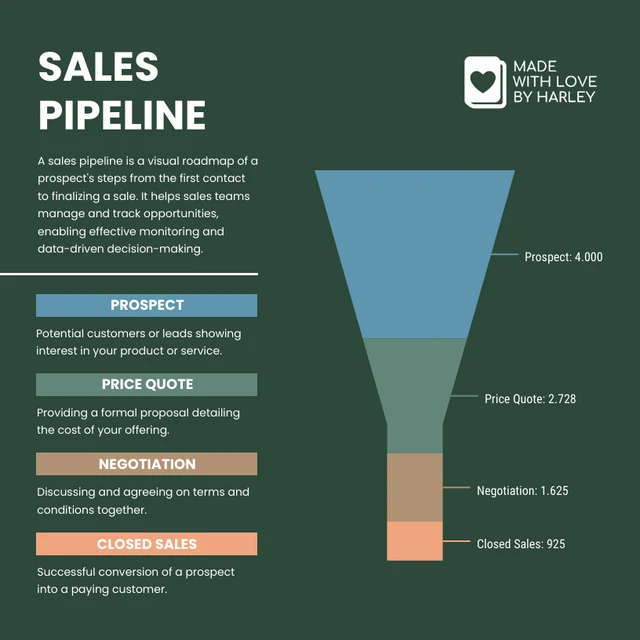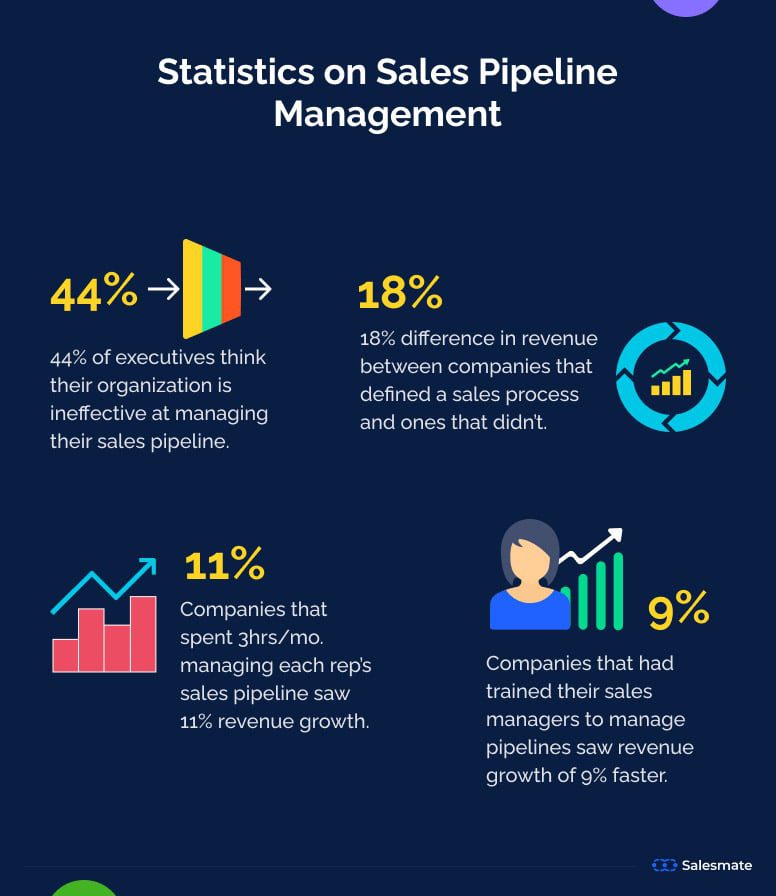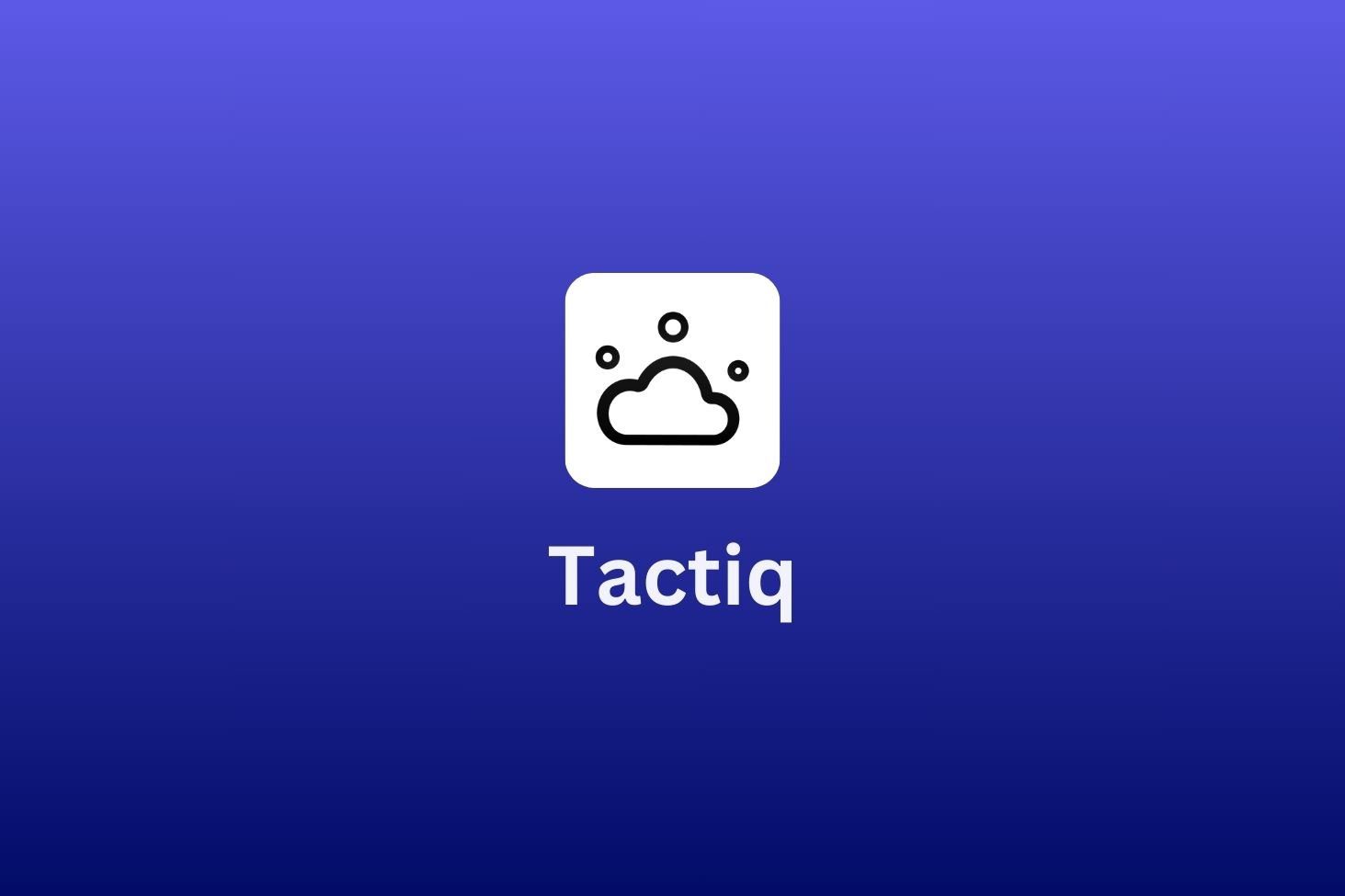When done right, pipeline management will give you insights into your sales processes like never before. It gives you the freedom to track, analyze, and organize your deals through your entire pipeline, empowering you to optimize your strategies for maximum efficiency.
You’ll be able to identify areas for improvement in the cycle, track the progress of your deals, and focus on the most promising opportunities to boost your revenue. The benefits of getting it right are almost never-ending.
In this article, we’ll focus on the top seven pipeline management tips. To make your life easier, we’ve broken them into categories so you can jump straight to the part you need the most help with. Let’s get started!
Understanding the Basics of Pipeline Management in Sales
The sales pipeline is a visualization of the sales journey for the customer, from the initial contact all the way to closing the deal. Here’s a better way of looking at it:

By viewing your entire pipeline, you get a high-level overview of the entire sales process. You can quickly figure out where prospects are getting stuck and which part of the pipeline is the smoothest.
Managing the pipeline requires numerous steps that you must follow to boost your sales revenue!
Tip 1: Define Clear Stages in Your Sales Pipeline
First and foremost, you need to make a firm decision: what are the stages in your sales pipeline? Without clear stages, your pipeline management turns to mush.
Stages can vary. The infographic above shows a simple sales pipeline with just four stages: prospecting, pricing, negotiation, and closing. However, pipelines can also consist of lead generation, lead qualification, engagement with leads, and even things like onboarding and customer retention.
Ensure that you have a clear overview from the get-go as it’s vital for organizing and digesting tasks. It’s also important to help decide who and what to prioritize.
When your whole team works from the same pipeline, it makes things clearer for everyone. Not only that but it will also provide the formula for great teamwork and collaboration. Did you know that companies that defined a sales process turn over 18% more than those that didn’t? Check out more pipeline management stats below.

Metrics That Matter in Pipeline Management
Effective sales pipeline management requires you to pay a great deal of attention to the metrics used to measure your sales success. Metrics are crucial in maintaining the health and efficiency of your sales pipeline, empowering you to identify great opportunities and locate areas to improve.
Some of the best metrics to keep in mind are as follows:
- Lead conversion rate. Use this to measure how effective your marketing and sales efforts are in converting leads into paying customers.
- Email open rate. Use this to measure the percentage of prospects who have opened up your emails.
- Client acquisition cost. This metric measures how much you have to spend to acquire new customers. The more leads you have, the higher the costs, which is why it’s so important to ensure the leads are of a high quality!
- Sales velocity. This measures how quickly you’re selling your product, offering insight into how much revenue you’re generating with time.
- Customer churn rate. A measurement to determine the percentage of your customers that have stopped doing business with your organization over a period of time.
- Pipeline velocity. Pipeline velocity is used to measure the speed at which your leads and deals move through different stages of the pipeline.
- Onboarding success rate. This is used to measure the amount of customers successfully onboarded to your company.
Tip 2: Track Metrics at Every Stage
If you’re constantly in the loop by tracking key metrics at every stage of your sales pipeline, you’ll automatically have a better overview and awareness of what needs to change and what’s working well. The quicker you draw attention to the weak areas, the easier they will be to fix.
Each stage has different metrics required to keep on top of your sales pipeline. As mentioned in the first tip, you are the ultimate decision maker when it comes to choosing the stages of your sales pipeline. However, we’ve broken them into the basic four here.
Stage 1: Prospecting
Prospecting involves identifying and attracting potential customers to build up your sales pipeline. The challenge here is to ensure that you’re sourcing the highest-quality leads in the fastest amount of time, preferably without breaking the bank.
It’s vital to track your client acquisition cost, lead volume, and costs per lead. With this information under your belt, you can slowly but surely maximize your prospecting efforts to produce top quality leads quickly and affordably.
Stage 2: Qualifying Your Lead
You can’t assume that every lead you pick up will be the right fit for your service. It’s integral to analyze the qualities of your leads and wean out the ones that you think aren’t ready to commit.
Focus on the lead qualification rate to get a better assessment here. This will help you strategize more effectively moving forward.
Stage 3: Sales Pitch and Negotiation
Address your prospect’s needs and concerns during your sales pitch and negotiations. You’re trying to sell the dream and seal the deal. Obviously, this doesn’t happen overnight so don’t let any deals clog up your pipeline.
Keep them moving along and maintain a watchful eye over your pipeline velocity. This will help you identify where users get stuck and help you remedy the situation.
Stage 4: Closing the Deal
Closing the deal is where you turn your prospects into paying customers. It’s the pinnacle of sales success. If you’ve mastered the other stages of your sales pipeline, the prospects should be more than willing to purchase at this point.
To track the final stage of your pipeline, keep an eye on your lead conversion rates. If you find that they’re dropping low, but everything else is going well, you might have to work with your team on closing the deal.
How to Check Your Pipeline for Efficiency and Health
If you want to be mindful of the quality of your pipeline, maintaining efficiency and health should be your number one priority.
Sales pipeline efficiency is defined by a high conversion rate, shortened sales cycle, and reduced number of lost deals. Simply put, it means guiding the prospect through the sales pipeline swiftly and efficiently so they go from prospect to customer with as little friction as possible.
Maintaining your sales pipeline health, however, requires more man management to make sure your sales team is:
- Generating plenty of high-quality leads;
- Moving those high-quality leads through the pipeline strategically, and;
- Getting those leads over the line and consistently converting them into paying customers.
According to Harvard Business Review, companies that mastered sales pipeline management saw 28% growth compared to those that didn’t. It shouldn’t take a rocket scientist to tell you if you don’t manage your pipeline effectively, you’re going to run into a lot of problems. Missed revenue being one of them.
Tip 3: Review Pipeline Metrics Regularly
Your sales team will benefit tremendously from regular reviews of the pipeline. Knowing the metrics to track is one thing, but ensuring you do it on a regular basis is something else entirely. Be consistent with your reviews and you’ll be rewarded for it.
Depending on the size of the organization and the specific stage of the pipeline you’re monitoring, this could be weekly, biweekly, or monthly. If you don’t review regularly, bottlenecks will go unnoticed in your pipeline, bringing deals to a standstill without any fix on the horizon. In short, your pipeline will be useless.
When everyone is clear on objectives and how to tackle obstacles if they pop up, it transforms your sales team from reactive to proactive.
Tools for Managing Your Pipeline’s Health
The most successful companies in the world make good use of sales pipeline tools, so why wouldn’t you? Without it, you’re taking a breadstick into a sword fight, destined to fail. Take this as your sign to check out the best sales tools on the market, amongst them some of the top tools to manage your pipeline!
Here’s the short version of the types of tools you need to manage your pipeline’s health:
- CRM software. CRM software helps you keep all your customer data organized, track interactions, and forecast sales.
- Sales analytics tools. You can get insights into your pipeline performance which helps you spot problems and bottlenecks in your pipeline. Not only that but you can keep an eye on the latest trends and predict your future revenue.
- Pipeline management software. Get an overview of your pipeline which helps you prioritize and streamline different sales processes.
- Lead scoring systems. Using lead scoring software allows you to focus your efforts on the highest-quality prospects with the most potential to convert into customers.
- Automation tools. Leveraging automation tools will dramatically reduce the time you have to spend doing mundane and repetitive tasks like follow-ups and reminders.
- Communication platforms. You should be using various types of communication platforms to build rapport with leads, whether that be via email or B2B selling on social media.
- Integration platforms. Integration platforms are essential to make data flow effortlessly from one system to the other.
- Performance dashboards. Imagine you have a complete bird’s eye view of your entire sales operation. This is what a performance dashboard is. You can monitor key metrics, keeping your pipeline healthy and flowing.
Tip 4: Use a CRM System
While most of the tools above are great, if you don’t have a CRM, you’re basically playing with a handicap.
There are multiple reasons why you should invest in a CRM system, especially if you’re looking to better manage your pipeline. A CRM will keep your pipeline organized and give you the luxury of easily managing every single prospect on your books. Not only does it help you keep everything in line but it streamlines certain sales processes, like generating leads for example.
With everything being centralized, customer transactions, preferences, and interactions are at the tip of your fingers so you can take a deep dive into any deal you want. Even better, the CRM is accessible by your entire sales team (and all your other customer interaction teams), meaning you have a central source of truth across your entire organization.
If you’ve been recording your sales calls with tl;dv, you can even get transcripts, video clips, and timestamps directly in your CRM.
Strategies to Keep Your Sales Pipeline Moving Efficiently
To ensure you keep your sales pipeline moving efficiently, prioritizing lead qualification is a must. High-quality prospects are essential to keeping things moving along. You can also automate your repetitive tasks by using automation tools, as well as provide more tailored follow-ups. There are tons of strategies but let’s focus on the most important.
Tip 5: Focus on Lead Quality Rather Than Quantity
Having 10 high-quality leads over 100 low-quality leads will always be more fruitful, so focus on the quality rather than the quantity.
If a lead is higher quality, they are more likely to buy. They may have heard of your brand already, or even be considering it as the solution to their problem, but the point is they are aware of who you are and what you do. For these high-quality leads, you don’t need to play the long game. You can get straight to the details of how your product or service can directly help them. They’ll be more receptive to you from the off.
With low quality leads, however, you first have to educate the prospect about your brand. If it’s not what they’re looking for, you’ve wasted your time.
“Quality is more important than quantity. One home run is much better than two doubles.”
Steve Jobs, Co-founder of Apple Tweet
Making this strategy one of your main focuses will improve your conversion rate and increase your customer lifetime value, subsequently reducing your customer acquisition cost. It’s a win-win-win!
When you prioritize these important metrics, you’ll not only boost your sales revenue but also enhance the reputation of your brand. Better leads create stronger relationships which create higher customer retention, loyalty, and referrals.
Sometimes leads need to be nurtured into high-quality leads, it’s easy to enrich your leads using remote sales software. You can also build a better rapport through targeted warm leads. These could be people who have visited your website, interacted with your social media content, or subscribed to your email list.
Finally, you can use lead scoring systems to prioritize leads by order of likelihood to convert. This pulls data from numerous sources to give you an accurate representation of which leads are quality and which ones are fluff.
Integrating Pipeline Management with Overall Sales Processes
Pipeline management is already integral to overseeing a lot of your sales processes.
The journey starts at the outreach stage, making that initial first call to introduce the prospect to the product and get further contact details.
Then comes the follow-up, to further solidify your relationship, address any initial concerns, and move the prospect down the funnel.
Negotiation follows shortly after. By viewing the pipeline as a whole, you can align solutions with the prospect’s priorities to convince them that your product is worth the price. Objections are easier to handle when you’ve been tracking your pipeline for so long. The same objections will come up over and over, and with time, you’ll figure out the ideal approach to unsticking the prospect at the objection stage.
And then closing the deal is where you get the name on the dotted line. Proper pipeline management will get more of these for you and your team by making the sales process as smooth as possible.
The most important thing to keep in mind is this;
Tip 6: Align Sales Goals with Pipeline Objectives
Ensure that your sales goals are aligned with the objectives of your pipeline management strategy. It’s crucial for driving success as you can break down these sales goals into actionable steps that correlate to each stage of the pipeline.
If your sales goals and pipeline goals are different or clashing, this will disrupt everything. Nothing will move forward as it just won’t make sense. Alignment is critical.
These alignments, from the first outreach call all the way to closing the deal, ensure that every aspect of the sales process contributes to moving prospects through the sales pipeline efficiently. It keeps your organization coherent and consistent, making sure all your teammates are working towards the same goals.
Tip 7: Provide Continuous Training and Coaching
Another way you can integrate pipeline management with overall sales processes is with continuous sales training. No one ever mastered something on the first attempt. By continuously training your team, you’re ensuring they’re ready and prepared for new strategies and challenges.
Make sure your team has the knowledge and tools to be the guardians of the sales pipeline. If you can train them how to keep the pipeline healthy and manage it efficiently, then it will make your company run smoother and your job will become a lot easier.
Teamwork makes the dream work. If you’re all operating under the same objectives, with the same training, and the same clear idea of the sales pipeline, then you develop a sense of trust and confidence that you can tackle any obstacle that comes your way.
A study found that companies that train their sales managers on the art of managing the sales pipeline had 9% greater revenue growth than those that neglected to do so.
You also need to provide training for:
- CRM software. To keep an eye on the leads and their statuses.
- Qualifying leads. To ensure you’re generating the right type of lead to keep your pipeline healthy.
- Pipeline metrics. To have knowledge of all the metrics you need to be following to ensure your pipeline runs smoothly and you get your leads from A to Z.
- Closing deals. To provide expertise and guile to your sales teams to ensure they know how to seal the deal.
Upgrade Your Pipeline Management Today
Keep your sales pipeline healthy and ticking along with these seven tips. Remember to define your pipeline stages from the very beginning so everybody is on the same page and working towards the same goals. But also never forget: quality over quantity.
It’s integral that you train everyone on pipeline management as your team must use the visibility it provides to identify and resolve bottlenecks. Otherwise, what’s the point of it?
Get started with your new pipeline management strategy today. Good luck!





